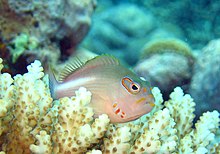Arc-eye hawkfish
| Arc-eye hawkfish | |
|---|---|

| |
| Paracirrhites arcatus in Polynesia | |
| Scientific classification | |
| Domain: | Eukaryota |
| Kingdom: | Animalia |
| Phylum: | Chordata |
| Class: | Actinopterygii |
| Order: | Perciformes |
| Family: | Cirrhitidae |
| Genus: | Paracirrhites |
| Species: | P. arcatus
|
| Binomial name | |
| Paracirrhites arcatus (G. Cuvier, 1829)
| |
| Synonyms[2] | |
| |
The arc-eye hawkfish (Paracirrhites arcatus), the ringeye hawkfish, horseshoe hawkfish or whiteline hawkfish, is a species of marine
hawkfish belonging to the family Cirrhitidae. It is found in shallow waters in the tropical Indo-Pacific on reefs
, resting on coral heads much of the time.
Taxonomy
The arc-eye hawkfish was first formally
Description

The arc-eye hawkfish has a relatively deep body, the
caudal fin.[5] The dorsal fin contains 10 spines and 11 soft rays while the anal fin has 3 spines and 6 soft rays, each dorsal fin spine being tipped with a branched cirrus.[6] This species reaches a maximum published total length of 20 cm (7.9 in).[2] This species has a variable background colour on the body, the typical colour being pale pinkish brown.[7] There is a horseshoe-shaped mark to the rear of the eye that consists of three thin lines. The gill cover has three orange bands set in a light blue area. A white to pink stripe is frequently present from around halfway along the flank and running to the rear.[8]
Distribution and habitat
The arc-eye hawkfish is widespread in the tropical
Ashmore Reef in the Timor Sea, and from the northern Great Barrier Reef and reefs in the Coral Sea south to the Solitary Islands in New South Wales. It has also been recorded at the Australian Indian Ocean territories of Christmas Island and the Cocos (Keeling) Islands; and the Tasman Sea locations of Middleton Reef, Elizabeth Reef and Norfolk Island. It is a benthic species associated with coral reefs. It usually can be found in lagoon and seaward reefs, at a depth of 1–30 m (3 ft 3 in – 98 ft 5 in), with a maximum of 91 m (299 ft).[2]


Biology
The arc-eye hawkfish is typically seen sitting motionless on the reef amongst corals.gametes.[2]
Utilisation
The arc-eye hawkfish is collected for, and is a relatively common species in, the aquarium trade.[9]
References
- ^ . Retrieved 20 July 2021.
- ^ a b c d e f Froese, Rainer; Pauly, Daniel (eds.) (2021). "Paracirrhites arcatus" in FishBase. June 2021 version.
- ^ a b Eschmeyer, William N.; Fricke, Ron & van der Laan, Richard (eds.). "Species in the genus Paracirrhites". Catalog of Fishes. California Academy of Sciences. Retrieved 20 July 2021.
- ^ Christopher Scharpf & Kenneth J. Lazara, eds. (25 February 2021). "Order CENTRARCHIFORMES: Families CENTRARCHIDAE, ELASSOMATIDAE, ENOPLOSIDAE, SINIPERCIDAE, APLODACTYLIDAE, CHEILODACTYLIDAE, CHIRONEMIDAE, CIRRHITIDAE, LATRIDAE, PERCICHTHYIDAE, DICHISTIIDAE, GIRELLIDAE, KUHLIIDAE, KYPHOSIDAE, OPLEGNATHIDAE, TERAPONTIDAE, MICROCANTHIDAE and SCORPIDIDAE". The ETYFish Project Fish Name Etymology Database. Christopher Scharpf and Kenneth J. Lazara. Retrieved 20 July 2021.
- ^ Randall, J. E. (1963). "Review of the hawkfishes (family Cirrhitidae)". Proceedings of the United States National Museum. 114 (3472): 389–451.
- ^ a b Bray, D.J. (2019). "Paracirrhites arcatus". Fishes of Australia. Museums Victoria. Retrieved 21 July 2021.
- ^ a b "Paracirrhites arcatus". Reef Life Survey. Retrieved 21 July 2021.
- ^ Mark McGrouther (20 April 2021). "Ringeye Hawkfish, Paracirrhites arcatus (Cuvier, 1829)". Australian Museum. Retrieved 21 July 2021.
- ^ "Paracirrhites arcatus". Saltcorner. Bob Goemans. Retrieved 21 July 2021.
- The Fishes of the Indo-australian Archipelago. Brill Archive. pp. 8–. GGKEY:05ZET4L61B1.
- Anonym, 2000. Data base of J.L.B. Smith Institute of Ichthyology, Grahamstown, South Africa.
- Anonym, 2001. Data base of National Museum of Natural History (Smithsonian Institution). Smithsonian Institution - Division of Fishes.
- Anonym, 2002. Data base of American Museum of Natural History. American Museum of Natural History, Central Park West, NY 10024–5192, United States.
- Gibbons, S., 1999. Collect fish on stamps. Stanley Gibbons Ltd., London i Ringwood. 418 p.
- Munz, F.W. i W.N. McFarland, 1973. The significance of spectral position in the rhodopsins of tropical marine fishes. Vision Res.13:1829-1874.
- Randall, J.E., 1986. Berlín.
- Robins, C.R., R.M. Bailey, C.E. Bond, J.R. Brooker, E.A. Lachner, R.N. Lea i W.B. Scott, 1991. World fishes important to North Americans. Exclusive of species from the continental waters of the United States and Canada. Am. Fish. Soc. Spec. Publ. (21):243 p.
- Wheeler, A., 1977. Das grosse Buch der Fische. Eugen Ulmer GmbH & Co. Stuttgart. 356 p.
- Wu, H.L., K.-T. Shao i C.F. Lai (eds.), 1999. Latin-Chinese dictionary of fishes names. The Sueichan Press, Taiwan.
External links
Wikimedia Commons has media related to Paracirrhites arcatus.
- BioLib
- Barcodes of Life
- NCBI
- AQUATAB
- Animal Diversity Web
- Encyclopedia of Life
- World Register of Marine Species
- ITIS
- UNEP-WCMC Species Database
- Photos of Arc-eye hawkfish on Sealife Collection

